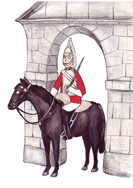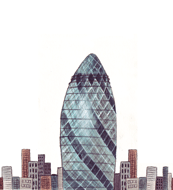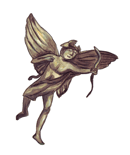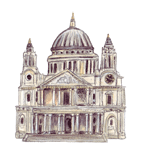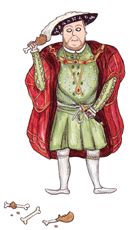 By the time he died, Henry VIII owned 50 palaces, a royal record for England, including three new ones in London: Hampton Court, Whitehall Palace (where he died) and St James’ Palace (where he lay in state).
By the time he died, Henry VIII owned 50 palaces, a royal record for England, including three new ones in London: Hampton Court, Whitehall Palace (where he died) and St James’ Palace (where he lay in state).
All in a stew …
Henry VIII, is best remembered for chopping his off wives’ heads, but he introduced a more gruesome death for poisoners. The Bishop of Rochester’s cook, taking vengeance against an ungrateful master, added a toxic herb to a dish and two guests died. Henry ordered that the cook should be boiled alive in his own pot and this remained the standard punishment for poisoners for five years.
Feast fit for a King
Henry VIII is famous for his 54 inch waist. In one month (November 1531) Henry and his friends ate 24 cows, 100 sheep, 51 deer, 91 pigs, 700 chickens, 444 pigeons, 168 swans and more than 400 larks.
I wonder what he had for pudding!
First service
 Henry VIII was a keen tennis player. He invented the ‘service’ – his servants used to throw the ball up in the air for him because he was too fat to do it himself. While his second wife Ann Boleyn was being beheaded at Tower Green, Henry played tennis at Hampton Court. The tennis court is still in use today.
Henry VIII was a keen tennis player. He invented the ‘service’ – his servants used to throw the ball up in the air for him because he was too fat to do it himself. While his second wife Ann Boleyn was being beheaded at Tower Green, Henry played tennis at Hampton Court. The tennis court is still in use today.
Kings
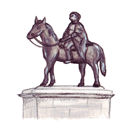 There have been 55 Kings of England. The first was King Egbert, who reigned from 827-830AD. The only time when there was no King or Queen in Britain was when the country was a republic between 1649 and 1660. (In 1649, King Charles I was executed and Britain became a Republic for 11 years. The monarchy was restored in 1660.)
There have been 55 Kings of England. The first was King Egbert, who reigned from 827-830AD. The only time when there was no King or Queen in Britain was when the country was a republic between 1649 and 1660. (In 1649, King Charles I was executed and Britain became a Republic for 11 years. The monarchy was restored in 1660.)
Jellied eels
Jellied eels are enjoyed by Pearly Kings in London’s East End. King Henry I wouldn’t have been keen. He died from indigestion in 1135 after eating an eel.
Jellied eels are a traditional dish from the East End of London. It’s sold by street vendors, although it can more usually be found in ‘pie and mash’ shops. It is commonly eaten with another East End delicacy ‘pie, mash and liquor’ – which used to be made with eel fat. Beef or lard is more common nowadays.
The eel was a readily available food resource for the capital, with eel fisheries in the Thames until pollution killed them off – they are back again now, in the cleaner river.
Horse Guards
Horse Guards Parade is a large parade ground. It was formerly the site of the Palace of Whitehall’s tilt yard, where tournaments were held between knights in armour in the time of Henry VIII. Today it is the scene of the annual celebrations of the Monarch’s official birthday — the Trooping of the Colour.
North, south, east, west – London is best.
Monument
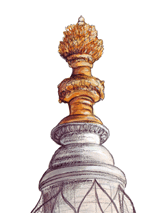 The Monument is a memorial to the Great Fire of London in 1666. It was designed by Christopher Wren and Robert Hooke, and built between 1671 and 1677. It measures 61 m (202-feet) – the exact distance from its base to Pudding Lane, where the fire broke out. A flaming copper urn sits upon the top, to symbolise the flames.
The Monument is a memorial to the Great Fire of London in 1666. It was designed by Christopher Wren and Robert Hooke, and built between 1671 and 1677. It measures 61 m (202-feet) – the exact distance from its base to Pudding Lane, where the fire broke out. A flaming copper urn sits upon the top, to symbolise the flames.
The Monument is the tallest single stone column in the world. You can also get a good view from above, by climbing the 311 steps to the Monument’s viewing platform.
London’s burning, London’s burning …
Eye pod
The Eye is tallest and the most popular paid tourist attraction in the UK, visited by over 3.5 million people each year. The London Eye has 32 pods and each pod represents one of the London boroughs.
Eye eye
The big wheel
London Eye (Millennium Wheel) stands 135 metres (443 feet) high on the South Bank of the River Thames between Westminster and Hungerford Bridges. When erected in 1999, it was the tallest Ferris wheel in the world.
Underneath the arches …
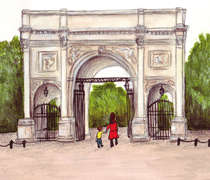 … we dream our dreams away, but 500 years ago the site of Marble Arch was a place of nightmares. Prisoners would “go west” to the Tyburn Tree (near Marble Arch) to be hanged in front of crowds large enough to fill Wembley Stadium.
… we dream our dreams away, but 500 years ago the site of Marble Arch was a place of nightmares. Prisoners would “go west” to the Tyburn Tree (near Marble Arch) to be hanged in front of crowds large enough to fill Wembley Stadium.
On the traffic island at the junction of Edgware Road and Marble Arch is a plaque, which marks the place where more than 50,000 people were executed, and only a few minutes walk away is the Tyburn Convent where the nuns still pray for the souls of those who died.
Gherkin
Eros
The statue of Eros was the first in the world to be cast in aluminium. The statue is generally believed to depict Eros but was intended to be an image of his twin brother, Anteros.
The sculptor Alfred Gilbert had already sculpted a statue of Anteros and, when commissioned for the Shaftesbury Memorial Fountain, chose to reproduce the same subject, who, as “The God of Selfless Love” was deemed to represent the philanthropic Earl of Shaftesbury suitably.
Careful what you say
The dome of St Paul’s Cathedral is the second biggest dome in the world, after St Peter’s in Rome. At its base is the Whispering Gallery, a circular walkway halfway up the inside of the dome. Due to the acoustics of the curved surface, a phrase whispered against one wall can be heard against the far wall 112 feet away.
St Paul’s
St Paul’s Cathedral was built between 1675 and 1711 by Sir Christopher Wren. The foundation stone was laid in 1675 when Wren was 43 years old, and the last stone was put in lace by his son 35 years later. It was the fifth cathedral on the site. The previous Norman one was even larger than Wren’s building and had the tallest ever spire. It was destroyed in the Great Fire of London of 1666.
Canary Wharf
The tallest building in London and the UK is Canary Wharf Tower, which is part of the London Docklands. It is 244 m or 800 ft high and was built in 1991.
Hickory dickory dock …
…. a flock of starlings stopped the clock. They landed on the minute hand of Big Ben in 1945 and moved it back by five minutes.


